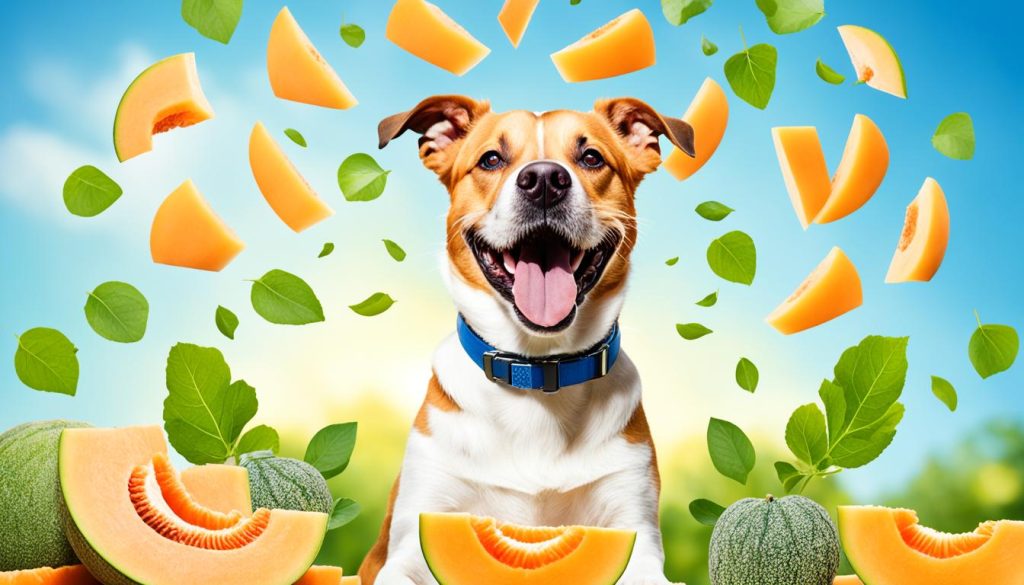Can Dogs Eat Cantaloupe? A Guide to Feeding Cantaloupe
Discover if can dogs eat cantaloupe, the benefits and portions suitable for your furry friend in this essential guide to cantaloupe feeding.

Did you know that cantaloupe is not only a delicious fruit for us humans, but it can also be a healthy treat for our four-legged friends? Many dog owners are unsure whether it is safe to feed cantaloupe to their pets. If you’ve ever wondered if dogs can eat cantaloupe, we provide all the necessary information you need here.
Can Dogs Eat Cantaloupe? Understanding the Basics
When it comes to feeding cantaloupe to your furry friend, it’s important to understand the basics. Many dog owners wonder, is cantaloupe safe for dogs? The good news is that yes, cantaloupe is generally safe for dogs to eat. However, like any other food, it should be given in moderation to ensure your dog’s health and well-being. Cantaloupe is a fruit that is rich in vitamins, minerals, and antioxidants which can provide several nutritional benefits for canines. It contains high levels of vitamin A and C, as well as fiber. These nutrients contribute to a strong immune system and healthy digestion in dogs.
Nutritional Benefits of Cantaloupe for Canines
Feeding cantaloupe to your dog can provide them with various nutritional benefits. The high fiber content in cantaloupe promotes healthy digestion and can aid in preventing constipation. Additionally, the vitamin A found in cantaloupe helps support good vision and a healthy coat for dogs.

While cantaloupe is safe for dogs to eat, it’s important to remember that moderation is key. Feeding excessive amounts of cantaloupe can lead to an upset stomach, diarrhea, or other digestive issues. It’s best to introduce cantaloupe slowly into your dog’s diet and monitor for any adverse reactions. It is advisable to consult your veterinarian to determine the appropriate portion sizes and feeding frequency for your specific dog.
Potential Health Benefits of Cantaloupe in a Dog’s Diet
Including cantaloupe in your dog’s diet can provide numerous health benefits. Cantaloupe is a natural source of vitamins and antioxidants, which are essential for supporting overall health and well-being in dogs. The high vitamin content in cantaloupe, such as vitamins A and C, can contribute to improved immune system function and help defend against common illnesses.
Moreover, cantaloupe is a hydrating fruit, consisting of about 90% water, making it an excellent choice for keeping your dog well-hydrated, especially during hot summer months. Hydration is essential for maintaining healthy body functions and preventing dehydration in dogs.
In addition to hydration, cantaloupe can also aid in digestion. The fruit is rich in dietary fiber, which can promote regular bowel movements and help prevent constipation in dogs. A healthy digestive system is vital for optimal nutrient absorption and overall digestive health. The antioxidants found in cantaloupe can also act as powerful anti-inflammatory agents, helping to reduce inflammation in the body and potentially improving joint health in dogs. This can be particularly beneficial for older dogs or those with joint-related issues.
Overall, including cantaloupe in your dog’s diet in moderation can be a great way to enhance their nutrition, support their immune system, and promote overall well-being.

Recognizing the Risks: When Cantaloupe Is Bad for Dogs
While cantaloupe can be a healthy and delicious treat for dogs, it’s important to be aware of the potential risks associated with feeding them this fruit. Understanding these risks can help you make informed decisions about whether or not to share cantaloupe with your furry friend. Cantaloupe rinds and seeds can pose a hazard to dogs if ingested. The hard and fibrous nature of the rind can be difficult for dogs to digest, potentially leading to gastrointestinal upset or blockages. Additionally, the seeds may pose a choking hazard or cause damage to your dog’s teeth or gums.
To prevent these risks, always remove the rind and seeds before offering cantaloupe to your dog. Cut the fruit into bite-sized pieces that are safe and easy for your dog to chew and digest. By taking these precautions, you can enjoy the benefits of cantaloupe without the potential dangers.
Sugar Content Concerns for Dogs with Specific Health Issues
The natural sugar content in cantaloupe may be a concern for dogs with specific health issues, such as obesity or diabetes. While cantaloupe is a healthier alternative to sugary treats, it’s still important to consider the overall sugar intake in your dog’s diet. If your dog has diabetes or is overweight, it’s essential to consult with your veterinarian before introducing cantaloupe into their diet. They can provide guidance on portion sizes and help you determine if cantaloupe is suitable for your dog’s specific health needs.
| Risks of Feeding Cantaloupe to Dogs | Hazards of Cantaloupe Rinds and Seeds | Sugar Content Concerns for Dogs |
|---|---|---|
| Potential gastrointestinal upset or blockages | Possible choking hazard or dental damage | Consideration for dogs with obesity or diabetes |
| Importance of removing rinds and seeds | Precautions when serving cantaloupe | Consultation with veterinarian for guidance |
How Much Cantaloupe Can a Dog Eat?
When it comes to feeding cantaloupe to your furry friend, it’s important to consider the right portion sizes and guidelines. While cantaloupe can be a healthy and refreshing treat for dogs, it should be given in moderation to avoid any potential issues.
The amount of cantaloupe a dog can safely consume depends on their size and individual needs. As a general guideline, it is recommended to offer cantaloupe as a supplement to your dog’s regular diet rather than as a staple food. This ensures a balanced and varied nutritional intake for your pet.
Here is a breakdown of how much cantaloupe you can feed your dog based on their weight:
| Dog’s Weight | Recommended Cantaloupe Portion |
|---|---|
| Small (up to 20 lbs) | 1-2 small slices or 1-2 tablespoons |
| Medium (20-50 lbs) | 2-3 slices or 2-3 tablespoons |
| Large (50-90 lbs) | 3-4 slices or 3-4 tablespoons |
| Extra Large (over 90 lbs) | 4-6 slices or 4-6 tablespoons |
Remember, these are just general guidelines, and you should always monitor your dog’s response to cantaloupe. Some dogs may be more sensitive to certain fruits, so it is essential to introduce new foods gradually and observe for any adverse reactions.
It’s also worth noting that cantaloupe should be given without the rind and seeds, as they can present a choking hazard or cause digestive problems. Always remove these parts before offering cantaloupe to your canine companion.
Are Dogs Allergic to Cantaloupe? Identifying Adverse Reactions
While cantaloupe can be a healthy and delicious treat for dogs, some dogs may experience allergic reactions or intolerance to this fruit. It is important to be aware of the signs of allergic reactions and know how to respond if your dog eats too much cantaloupe. Dogs allergic to cantaloupe may exhibit various symptoms that indicate an adverse reaction.
These signs can include:
Itching
Hives or skin rashes
Swelling, especially around the face, ears, or mouth
Difficulty breathing
Vomiting
Diarrhea
Abdominal pain
If you notice any of these signs after your dog consumes cantaloupe, it is essential to seek veterinary attention promptly. Allergic reactions can range from mild to severe, and immediate medical intervention may be necessary to ensure your dog’s well-being.
How to Respond If Your Dog Eats Too Much Cantaloupe
If your dog happens to eat too much cantaloupe, it is crucial to monitor their behavior and health closely.
Signs of overindulgence in cantaloupe can include:
Upset stomach
Diarrhea
Excessive water consumption
If these symptoms persist or worsen, or if you are unsure about your dog’s condition, it is best to contact your veterinarian for guidance. They can provide specific advice based on your dog’s individual health needs. Remember, while cantaloupe can be a healthy addition to your dog’s diet, it is important to introduce it gradually and in moderation, paying close attention to any potential allergic reactions or adverse effects.
Innovative Ways to Include Cantaloupe in Your Dog’s Treats
Looking for creative and delicious ways to treat your furry friend? Including cantaloupe in your dog’s treats can add a burst of flavor and some extra nutrients to their diet. Here are a few innovative ideas to get you started:
1. Whip up a refreshing and healthy ice cream treat for your dog by blending cantaloupe chunks with plain yogurt or coconut milk. Pour the mixture into ice cube trays or use a silicone mold for fun shapes. Freeze until solid and serve it to your pup on a hot summer day.
2. An easy and quick treat option is making frozen cantaloupe cubes. Simply cut the cantaloupe into bite-sized pieces and freeze them on a baking sheet. Once frozen, transfer the cubes into a container and store them in the freezer. These icy treats can be given to your dog as a refreshing snack or used as food toppers.
3. Combine the goodness of cantaloupe with other dog-friendly ingredients to make pupsicles. Blend cantaloupe, banana, and a splash of water to create a smooth mixture. Pour the mixture into popsicle molds or ice cube trays and freeze until solid. These homemade popsicles will keep your dog cool and satisfied on hot days.
When using cantaloupe in your dog’s treats, it’s important to take some safety precautions. Remember to remove all seeds and rinds, as they can be a choking hazard or cause digestive issues. Additionally, always serve treats in appropriate portion sizes to avoid overfeeding. Now you have some exciting ideas to include cantaloupe in your dog’s treats. Get creative and enjoy treating your pup with these tasty and healthy options!
FAQs on Can dogs eat cantaloupe?
What are the nutritional benefits of cantaloupe for dogs?
Cantaloupe is a good source of fiber and vitamins, which can benefit a dog’s digestion, hydration, and immune system.
How much cantaloupe can a dog eat?
The amount of cantaloupe a dog can safely eat depends on its size. It is important to feed cantaloupe in moderation and monitor for any adverse reactions.
Are dogs allergic to cantaloupe?
Some dogs may be allergic or intolerant to cantaloupe. Common signs of allergic reactions include itching, swelling, or gastrointestinal upset. If you suspect your dog is allergic, consult a veterinarian.
What should I do if my dog eats too much cantaloupe?
If your dog consumes an excessive amount of cantaloupe, monitor for any signs of gastrointestinal upset and contact your veterinarian for guidance.
Can dogs eat cantaloupe rinds or seeds?
No, cantaloupe rinds and seeds can pose a choking hazard and cause gastrointestinal upset in dogs. Remove the rind and seeds before feeding cantaloupe to your pet.
How can I include cantaloupe in my dog’s treats?
You can make creative cantaloupe treats for your dog, such as cantaloupe ice cream, frozen treats, or food toppers. Always remove the seeds and rinds, and use appropriate portion sizes.





